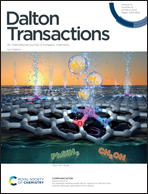Pyrene-based fluorescent Ru(ii)-arene complexes for significant biological applications: catalytic potential, DNA/protein binding, two photon cell imaging and in vitro cytotoxicity†
Abstract
Ruthenium complexes are being studied extensively as anticancer drugs following the inclusion of NAMI-A and KP1019 in phase II clinical trials for the treatment of metastatic phase and primary tumors. Herein, we designed and synthesized four organometallic Ru(II)-arene complexes [Ru(η6-p-cymene)(L)Cl] (1), [Ru(η6-benzene)(L)Cl] (2), [Ru(η6-p-cymene)(L)N3] (3) and [Ru(η6-benzene)(L)N3] (4) [HL = (E)-N′-(pyren-1-ylmethylene)thiopene-2-carbohydrazide] that have anticancer, antimetastatic and two-photon cell imaging abilities. Moreover, in the transfer hydrogenation of NADH to NAD+, these compounds also display good catalytic activity. All the complexes, 1–4, are well characterized by spectroscopic techniques (NMR, mass, FTIR, UV-vis and fluorescence). The single crystal X-ray diffraction technique proved that the ligand L coordinates through an N,O-bidentate chelating fashion in the solid-state structures of complexes 1 and 2. The stability study of the complexes was performed through UV-visible spectroscopy. The cytotoxicities of all the complexes were screened through MTT assay and the results revealed that the complexes have potential anticancer activity against various cancerous cells (HeLa, MCF7 and A431). Studies with spectroscopic techniques revealed that complexes 1–4 exhibit strong interactions with biological molecules i.e. proteins (HSA and BSA) and CT-DNA. The density functional theory (DFT-D) method has been employed in the present study to know the interaction between DNA and complexes by calculating the HOMO and LUMO energy. A plausible mechanism for NADH oxidation has also been explored and the DFT calculations are found to be in accord with the experimental observation. Furthermore, we have investigated intracellular reactive oxygen species (ROS) generation capabilities in the MCF7 breast cancer cell line. The Hoechst/PI dual staining method confirmed the apoptosis mode of cell death. Meanwhile, complexes 1–4 show capabilities to prevent the metastasis phase of cancer cells by inhibiting cell migration.



 Please wait while we load your content...
Please wait while we load your content...